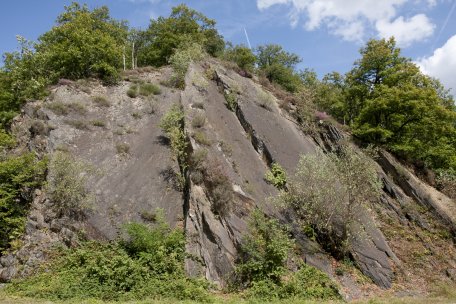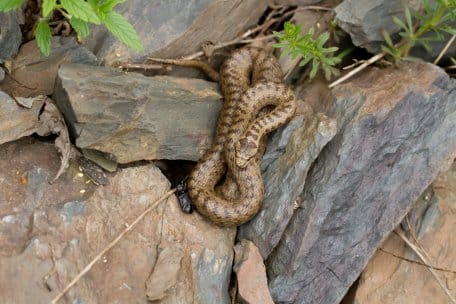Exposed rocks represent extreme locations
Rocks can be found in many places in the Eifel National Park: either scattered as boulder fields in the oak forest or standing individually, like the rocky complexes towering over the forest. They are most striking along the trail by the Urft dam (county road no. 7, K7) Striking individual rocks can also be found in the National Park districts of Hetzingen and Dederborn. Some rock formations owe their current state to previous usage as slate mines, as quarries for road-building or for the construction of the Urft dam.
Geologically speaking, these rocks consist of greywacke, shale or sandstone; in other words, siliceous rocks with a low lime content. In addition to the type of stone and the direction of the sun, the degree of shade is decisive for living conditions on the rocks. Rock toes or higher surfaces of rocks, which are shaded by trees, offer completely different living conditions to the top of rocks that are exposed to the sun.
The dark and damp microclimate of shaded rocks in forests provides the ideal conditions for moss and fern. Foliage or needles can lead to the formation of humus in cracks and alcoves, which also in turn provides space for grasses and herbs to lay down their roots. Semi-shaded rocks are the original habitat of heather, as well as other moorland vegetation. Nowadays, it grows on large, man-made sandy areas, such as the Drover Heide or Schavener Heide near the National Park.
Exposed rocks represent extreme locations due to their warm and dry microclimate. The only plants and animals that can survive here are those that have adapted to these special conditions. Colourful lichen, herbs with thick, hairy, water-retaining leaves, reptiles and certain types of butterfly feel at home here.
The rocks do not require any conservation measures and are thus part of the process conservation zone. Their flora and fauna, which are often rare and endangered, are very sensitive, however, and must be safeguarded with special measures. Lichen grows very slowly, for example, but can be quickly destroyed when stepped on. As such, climbing rocks is forbidden in the National Park (see National Park Decree, NP-VO).


